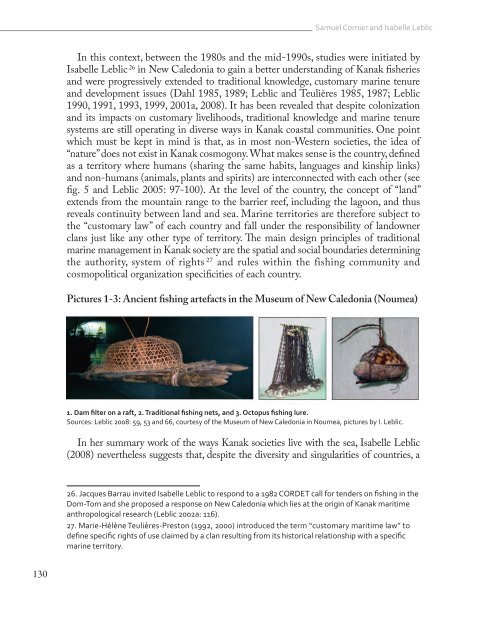Fisheries in the Pacific
Fisheries_in_the_Pacific
Fisheries_in_the_Pacific
Create successful ePaper yourself
Turn your PDF publications into a flip-book with our unique Google optimized e-Paper software.
Samuel Cornier and Isabelle Leblic<br />
In this context, between <strong>the</strong> 1980s and <strong>the</strong> mid-1990s, studies were <strong>in</strong>itiated by<br />
Isabelle Leblic 26 <strong>in</strong> New Caledonia to ga<strong>in</strong> a better understand<strong>in</strong>g of Kanak fisheries<br />
and were progressively extended to traditional knowledge, customary mar<strong>in</strong>e tenure<br />
and development issues (Dahl 1985, 1989; Leblic and Teulières 1985, 1987; Leblic<br />
1990, 1991, 1993, 1999, 2001a, 2008). It has been revealed that despite colonization<br />
and its impacts on customary livelihoods, traditional knowledge and mar<strong>in</strong>e tenure<br />
systems are still operat<strong>in</strong>g <strong>in</strong> diverse ways <strong>in</strong> Kanak coastal communities. One po<strong>in</strong>t<br />
which must be kept <strong>in</strong> m<strong>in</strong>d is that, as <strong>in</strong> most non-Western societies, <strong>the</strong> idea of<br />
“nature” does not exist <strong>in</strong> Kanak cosmogony. What makes sense is <strong>the</strong> country, def<strong>in</strong>ed<br />
as a territory where humans (shar<strong>in</strong>g <strong>the</strong> same habits, languages and k<strong>in</strong>ship l<strong>in</strong>ks)<br />
and non-humans (animals, plants and spirits) are <strong>in</strong>terconnected with each o<strong>the</strong>r (see<br />
fig. 5 and Leblic 2005: 97-100). At <strong>the</strong> level of <strong>the</strong> country, <strong>the</strong> concept of “land”<br />
extends from <strong>the</strong> mounta<strong>in</strong> range to <strong>the</strong> barrier reef, <strong>in</strong>clud<strong>in</strong>g <strong>the</strong> lagoon, and thus<br />
reveals cont<strong>in</strong>uity between land and sea. Mar<strong>in</strong>e territories are <strong>the</strong>refore subject to<br />
<strong>the</strong> “customary law” of each country and fall under <strong>the</strong> responsibility of landowner<br />
clans just like any o<strong>the</strong>r type of territory. The ma<strong>in</strong> design pr<strong>in</strong>ciples of traditional<br />
mar<strong>in</strong>e management <strong>in</strong> Kanak society are <strong>the</strong> spatial and social boundaries determ<strong>in</strong><strong>in</strong>g<br />
<strong>the</strong> authority, system of rights 27 and rules with<strong>in</strong> <strong>the</strong> fish<strong>in</strong>g community and<br />
cosmopolitical organization specificities of each country.<br />
Pictures 1-3: Ancient fish<strong>in</strong>g artefacts <strong>in</strong> <strong>the</strong> Museum of New Caledonia (Noumea)<br />
1. Dam filter on a raft, 2. Traditional fish<strong>in</strong>g nets, and 3. Octopus fish<strong>in</strong>g lure.<br />
Sources: Leblic 2008: 59, 53 and 66, courtesy of <strong>the</strong> Museum of New Caledonia <strong>in</strong> Noumea, pictures by I. Leblic.<br />
In her summary work of <strong>the</strong> ways Kanak societies live with <strong>the</strong> sea, Isabelle Leblic<br />
(2008) never<strong>the</strong>less suggests that, despite <strong>the</strong> diversity and s<strong>in</strong>gularities of countries, a<br />
26. Jacques Barrau <strong>in</strong>vited Isabelle Leblic to respond to a 1982 CORDET call for tenders on fish<strong>in</strong>g <strong>in</strong> <strong>the</strong><br />
Dom-Tom and she proposed a response on New Caledonia which lies at <strong>the</strong> orig<strong>in</strong> of Kanak maritime<br />
anthropological research (Leblic 2002a: 116).<br />
27. Marie-Hélène Teulières-Preston (1992, 2000) <strong>in</strong>troduced <strong>the</strong> term “customary maritime law” to<br />
def<strong>in</strong>e specific rights of use claimed by a clan result<strong>in</strong>g from its historical relationship with a specific<br />
mar<strong>in</strong>e territory.<br />
130


